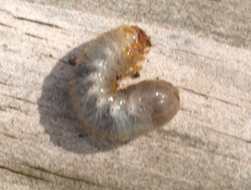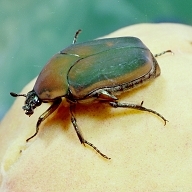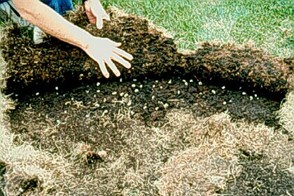Lawn Grubs and Grub Control

Lawn grubs, also called grub worms or white grubs, are actually beetle larva.
There are a few types that damage lawns. They are the larva of the:
- June Beetle
- Green June beetle
- Japanese Beetle
- Masked Schafer Beetle
- Black Turfgrass Ataenius Beetle
Healthy lawns are able to withstand a few grubs per square foot. This is because grass growth will outpace the grub feeding. However, too many lawn grubs will outpace root growth and damage results. If grub controls are necessary, it should be applied before any damage occurs.
More environmentally friendly "preventative" herbicides are far more acceptable to many people than "quick kill" herbicides that offer an immediate cure. Preventatives can be insect specific (unlike quick kill types) and must go down earlier in the year, long before the beetle larva become a problem, but may have little affect when larva are at the damaging stage.
The greatest damage will usually be in the last stages of grub growth as lawn grubs reach their maximum size. Since the life cycles of the various species of lawn grubs are known, the damage they do and the time of year that damage will likely occur is predictable.
May/June Beetle Lawn Grubs
June Beetle Info at a Glance

- C-Shaped grubs with a three year life cycle.
- Larva feed on grass roots and are lawn destroying insects.
- The end of summer the second year is when the larva does the greatest damage.
- Red adult beetles emerge the third year in May or June.
- Beetles fly at night and are attracted to lights.
- Photo taken by Russ James.
The larva of the May/June beetles, also called May or June bugs, are white c-shade grubs that have a three year life cycle. Noticeable damage to the turf doesn’t occur until late in the second year. For the best control, a basic knowledge of life cycles is important.
First Year
Eggs are laid in the soil during the flight stage of June beetles. The eggs hatch and the small larva begin feeding on grass roots. The insects are so small at this stage that there is no visible damage to the grass. By the end of summer these lawn grubs are still about ¼ inch long. As the soil cools in the fall, the insects begin to move deeper into the soil and over-winter below the frost line.
Second Year
In spring as the soil warms, the small grubs will emerge from dormancy and begin feeding. Grubs will feed for up to six months and will obtain their full size by the end of summer. It is during the summer of the second year that the majority of damage can be seen. In the fall as soil temperatures begin to cool, the grubs again burrow deeper into the soil in preparation for winter.
Third Year

During the spring of the third year, once again the lawn grubs move to the soil surface. However, the third year there is only a little feeding since they have already reached their full size. In late summer the grubs are ready to pupate. Pupation is usually complete by the end of September. Since temperatures will begin cooling soon, they will remain in the soil until May of the following year when they begin to emerge as winged adults. Depending on the species, they may emerge anytime from May through July. (Photo courtsey of the University of Nebraska Entomology Department. Used by permission)
At this point the cycle repeats itself as the adults mate, lay eggs in the soil and die.
The adults fly only at night and remain buried in the soil during the day. You have probably seen them flying around the porch light or flying into screen doors.
Grub Damage
The first signs of damage will be seen in late July or August. Damage begins as a thinning of the grass. From there it progresses to patches of grass that will quickly wilt and die. It will often occur quickly over a period of several days. Once the grass is severely damaged, it will need to be replanted or reseeded at the appropriate time for your specific grass type. Weeds will often encroach in the area taking advantage of the weakness in the turf.
It should be noted, however, healthy grass is able to withstand up to 5 grubs per square foot. It is when they exceed that margin that damage really begins to show. Once the adult beetle emerges from the soil, the life of the beetle is short lived. You can probably count on having the same problems again in the following years unless action is taken to break the cycle.
Green June Beetle

Green June bug info at a glance
- Green June beetles have a one year life cycle.
- Larva are not lawn destroying insects, but adults can feed on fruit.
- Larva feed on decaying organic matter
- Larva crawl on their backs with their feet in the air.
- Adults are often confused with Japanese beetles.
- Beetles fly during the daylight hours.
The green June beetle grub and winged adults are slightly larger in size than the May/June Beetle although the lawn grubs look similar. They have a couple different habits that make them stand out from their grub cousins. (Photo of Green June Bug courtesy of Clemson University)
How the Green June Beetle Larva Differ

The first major difference is what it eats. The green June Beetle is not a lawn destroying insect. It primarily feeds on decaying soil organic matter. The mature winged adults feed on fruit. Soft fruits like peaches are favorite targets and can be found on healthy fruit and decaying fruit on the ground as well.
The second distinction is how the grub crawls. At night when they come to the surface green June beetle larva will crawl on its back with its feet in the air. It is the only grub to do this. When found in the soil it will not be quite as C-shaped as other lawn grubs. (Photo by Russ James)

Note: The adult green June bug is often confused with the Japanese beetle since they both have some green in them. If you look at the photo, the adult Japanese beetle has a row of white spots on each side of its body. Green June beetles do not have any white spots. If you see a Japanese beetle in your area, be sure to report it to your county extension office or Dept. of Conservation. The Japanese beetle is a serious pest. Most states have quarantine measures that are enacted where the insect is found.
Life Cycle of Green June Beetle
Green June beetles have a one year life cycle. The female beetle looks for organic matter or fertile soils to lay her eggs. Soils with decaying manure, litter, leaves, stray or hay make good prospects for the female beetle.
The eggs hatch in about two weeks and the larva start feeding immediately. In the fall, as temperatures begin to drop, the larva will have reached their full size. As winter approaches it will dig below the freeze point and hibernate. In the spring it will again move upward to the surface. In April and May it will form a small chamber in preparation to pupate. Pupation generally lasts for two to three weeks. The adult beetle will then emerge as a winged adult. June and July is the most common flight times, but may vary with locations.
Unlike their June bug cousins, Green June beetles fly during the day and burrow into the soil at night.
Lawn Grub Damage
Most of the damage caused by the green June bug is from tunneling. A few tunnels are actually beneficial by loosening and aerating the soil. A large number of grubs can cause the soil to dry out faster. In dry climates this can be more serious. Where tunnels are extensive, the ground will be somewhat spongy.
Indirect evidence may be small holes where animals have been digging for lawn grubs. Armadillos and skunks are noted for this.
Masked Schafer Beetle
Masked Schafer Beetle info at a glance
- Masked schafer beetles have a one year life cycle. Larva are lawn destroying insects.
- Larva are 3/4 inches, half the size of June beetle larva.
- Damage to roots in is late summer and grass can often be lifted like a carpet.
- Adult red beetles are half the size of adult June beetles.
- Beetles fly at night and are attracted my lights.
Masked schafer beetles, also called "annual grubs" have a one year lfe cycle. Masked Schafer adults are similar in appearance to June beetles, but about half the size. The lawn grubs are white with a redish-brown head, six legs and are c-shaped.
Life Cycle of the Masked Schafer Beetle
Masked Schafer beetles have one generation per year. In late spring to early summer, winged female adults tunnel into the soil to lay eggs. Eggs hatch a few weeks later and the tiny grubs immediately begin feeding on organic matter and grass roots.
By the end of summer, masked Schafer grubs have reached their full size. When numbers exceed 6 to 7 grubs per square foot, severe damage can occur. Damage usually shows by late summer or early fall. As the temperature drops in the fall, the mature grubs will tunnel deeper into the soil in preparation for winter.
As spring temperatures rise, the grubs emerge from hibernation. In May they will prepare to pupate. Two to three weeks later an adult emerges from the soil and looks for a mate.
Like the June beetle, masked schafers fly at night and are attracted by porch lights, headlights, or any other source of light.
Grub Damage
Damage occurs when there are more than 6 to 7 grubs per square foot. Look for damage to occur in August to September.
Grass will turn tan or brown in increasing larger patches as the lawn grubs feed.

In less severe cases, grass has the appearance of being drought stressed. However, when water is applied, it will usually not help since moisture is not the problem. The weakened grass becomes more susceptible to environmental stresses and weed invasion.
In more severe cases, the grass will easily pull up from the soil as the roots are being cut. In the worst cases, you can actually lift and roll up the grass like a rug. (Photo courtesy of University of Nebraska Entomology Department. Used by Permission.)
Black Turfgrass Atenius
Black Turfgrass Atenius info at a glance
- Beetles have only a five month life cycle.
- Grubs are very small and are only a quarter inch long.
- They are not a major problem for home lawns.
- Bentgrass greens are most affected.
- Found mostly in the northern half of the U.S.
- Takes 30 to 40 grubs per square foot to cause severe damage.
Black Turfgrass Atenius lawn grubs are very small, only ¼ inch long. These small grubs feed on bentgrass, annual bluegrass and Kentucky bluegrass. They are primarily a problem on golf course greens, but will occasionally attack home lawns. Northern states are more affected, due in part because bentgrass and bluegrass are cool season grasses that are more prominent in the cooler areas of the north.
Life Cycle of BTA Beetles
Adults beetles overwinter in organic material, loose soil, thatch, or any suitable material. As soon as it warms up in March or April the adults lay eggs in the soil on bentgrass or bluegrass golf greens and lawns. The eggs hatch in one to two weeks and immediately begin moving feeding on roots. It only takes 3 to 5 weeks for grubs to mature enough to pupate. Adult beetles emerge from the soil in late July or August. The adults mate, lay eggs in the soil or thatch and the process begins again. A second generation emerges from the soil in October, but will wait until the following spring to mate.
Grub Damage Description
Damage begins as small brown patches of thinning and dying grass. The patches enlarge as the grubs feed on fresh roots. Roots will be pruned as deep as one inch into the soil. Damaged grass can easily be pulled up in clumps or in severe cases can be rolled up like a rug. Underneath you will find several small C-shaped grubs.
A few grubs are not a concern. Extensive damage begins when numbers reach 30 to 40 grubs per square foot range.
Factors That Affect Grub Numbers and Damage
The old saying is "If you have had problems with lawn grubs before, you will have them again". This means you have the soil type they are looking for. Soils high in organic matter are prime targets.
You can check for grubs by slicing and lifting a small section of turf. Slice the turf a few inches deep using a knife (careful not to cut yourself) or shovel on three sides and lift up the grass. Grass growing in sunny locations will usually reveal more grubs than grass growing is shaded areas.
For egg development, adequate soil moisture is needed. Eggs can’t move around to locate better conditions, so if the soil becomes too dry the beetle eggs dry out and die. Dry conditions can be a natural means of keeping beetle populations under control. If your grass is healthy and you are having a drier than normal spring or summer, you can allow your lawn to remain dry. Be careful, however, your grass will show signs, such as color change, when it is in need of irrigation.
Grub Control Products
There are several types of grub controls from fast acting grub killer products to slower acting season long insecticides. Newer and more environmentally safe biological products are available. Some of these products are insect specific. Below is a list and description of available lawn grub control products.
Quick Kill Products
If you are currently experiencing damage from grubs you don't want a product that will begin killing grubs a month after it was applied. Instead, you will need a fast acting lawn grub control product.
- Dylox (trichlorfon): An example is Bayer Advanced 24 Hour Grub Control. Products with trichlorfon is one of the best fast acting products on the market.
Preventitive Lawn Grub Products
If you have had damage in previous years and want to treat your lawn before damage occurs you can use a slower acting lawn grub control product. Look for products with the active ingredient:
- Merit (imidacloprid): An example is “Bayer Advanced Season Long Grub Control”. Merit is a preventative product and not a curative. This means it must be applied at least a month or longer before any grub damage occurs. It will probably have little or no effect if applied at the time of turf damage.
- Mach 2 (halofenozide): Mach 2 is a biological control that mimics the insect molting hormone causing a premature molt. This premature molt is lethal to the grub. Mach 2 is also a preventative control product and must be applied a before any damage occurs to be effective. This product is somewhat insect specific and will have no effect on beneficial insects.
- Milky Disease Spores: This is a product that is labeled for lawn grubs and can be purchased online and in some lawn and garden stores. However, in controlled tests milky disease spores have not proven to provide reliable control. Note: Milky disease spores have shown to have no effect on masked Schafer grubs.
- Beneficial nematodes: This is another biological control that is labeled for control of lawn grubs. However, it too has not proven very reliable in controlled tests. At best the test results were sporadic.
Red Imported Fire Ants
These dangerous ants are found throughout the southern U.S. and will fiercely defend their nests whenever it is disturbed. To the unwary person, dozens of painful stings can occur within seconds. Learn valuable information about these insects and the methods used to control them.
Lawn Moles and Voles
Moles can be very frustrating to deal with. Some people learn to live with them, but you don't have to. Knowledge is the key to getting rid of moles.
Getting Rid of Fleas from House and Lawn
Although fleas are not a danger to your lawn, they can be extremely frustrating to your pets and family. Infestations can occur when fleas are out of control or when control methods are inadequate. Click here for complete information for getting rid of fleas.
Cat and Dog Flea Medicines that Work
Applying flea and tick medicines on your pet is the first step in preventing an infestation. Click here to see a list of products that work and how they are used.
Bald Faced Hornet Facts and Removal
Bald faced hornets, distinguished by their large round or oval nests, have a fierce reputation. They will defend their nest with multiple stings. Learn tips for safely removing a nest without getting stung.
Lawn Grubs back to Turf Pests Landing Page
Lawn Grubs back to Lawn Care Academy Home



